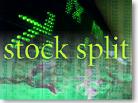|
Wall St.'s split personality
|
 |
July 15, 1998: 3:41 p.m. ET
Stock splits come in bunches, but anticipating who's next is difficult
|
NEW YORK (CNNfn) - Wall Street has developed a split personality lately, with many firms splitting their stocks to pique investor interest, but anticipating who'll be next is less certain.
Stock splits, in which a company divides its stock and distributes proportionally more to its shareholders, tend to go in waves and recently it's happening again.
The most notable sector to participate in this trend is Internet-related stocks. Internet service provider Mindspring Enterprises Inc. (MSPG) got things rolling with a three-for-one stock split announcement in late June.
That was followed by a stampede of stock splits among Internet search engine firms, including Excite Inc. (XCIT), Lycos Inc. (LCOS) and the largest of them all, Yahoo! Inc. (YHOO). Another ISP, Earthlink Network Inc. (ELNK) declared one as well.
Splits haven't been confined to tech stocks. Blue chip entertainment company Walt Disney Co. (DIS) split 3-1 while Delta Air Lines Inc. (DAL) announced Tuesday a 2-1 split.
More stocks, more investors
Companies have a variety of reasons for splitting their stocks but the main impetus is usually to make the stock more desirable to investors.
When a company splits its stock, the share price is divided by the proportion of the split. For example, if XYZ Co. stock is trading at $100 per share and you own one share, a 2-1 stock split will give you two shares at $50 each.
Once a company has done that, others may give the stock a closer look. An investor who was put off by a three-digit stock price may be more inclined to purchase shares which are half that price. For this reason, stock splits tend to be as much psychologically motivated as they are fiscally motivated.
Additionally, a company may declare a stock split to widen its shareholder base, which will tend to make the shares more liquid and lessen the impact of any position changes by institutional investors.
Once a company announces a split, the shares tend to rise in anticipation of these benefits. However, taking advantage of a stock split requires you to be in the right place at the right time.
When a company makes its split declaration, it will set a "record" date. This is the date on which a shareholder must own a stock in order to participate in the stock split. So if on August 1 a company announces a split with a record date of August 10, you'll have to own stocks by that date.
However, on August 1 you, along with many others, will want to buy that stock which often pushes the price higher. For this reason, to get the most bounce from a stock split you'll want to own it before the announcement is made.
Unfortunately, predicting a split is next to impossible, even for Wall Street professionals like Paul Cherney, a market analyst with Standard & Poor's.
"I have never been able to come up with any clear indicators," said Cherney. "There is no mechanical means to identify them."
Barring a scientific process, Cherney and others are forced to use hunches. He explained generally a stock that can be split will have a price of more than $55, while blue chips that split tend to be above the $100 mark.
Since companies want momentum to take the best advantage of a stock split, they'll attempt to do it when they're on a roll. Their share prices should be on an upward trend and they usually have experienced several quarters of increasingly improving performance.
"The last thing you want to do is split your stock and let if flounder around," said Mike Oyster, senior quantitative analyst at Schaeffer's Investment Research.
Reverse splits
But winners aren't the only ones who attempt this strategy. Firms whose shares have been beaten down recently may try what's known as a reverse stock split.
A reverse split reduces the number of available shares. For example, if ABC Co. sets a 1-2 stock split and you own 10 shares at $5 (a total holding of $50), after the split you'll own 5 shares at $10 per share.
Firms taking this road are hoping a higher price will make the stock appear more popular and lure other investors who want to get on a rising equity.
When a sector is doing well and one or two companies declare stock splits, others in that sector often follow. This was illustrated recently as one search engine company split foreshadowed others. Tech stocks tend to be best-suited for the type of momentum which triggers splits.
"You're going to see a lot more technology companies making a higher move in a shorter period of time," said Oyster. "Blue chips don't tend to make those quick moves."
If you're a long-term investor and are fortunate enough to have anticipated a stock split, you probably won't want to change your strategy with that stock after the split.
"If you bought the stock because you liked the fundamentals, you'll want to stick with it," said Cherney.
-- by staff writer Randall J. Schultz
|
|
|
|
|
 |

|

